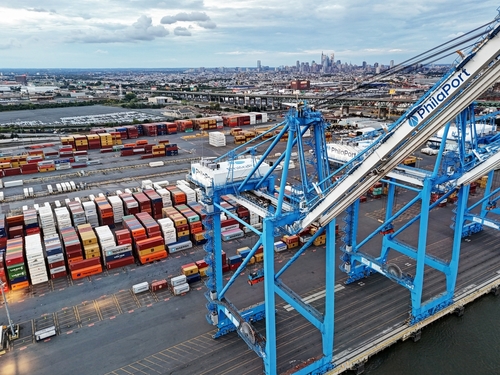
As demand and cargo volumes continue to increase, the Port of Philadelphia (PhilaPort) plans to build the necessary capacity to accommodate the next several decades of growth, according to its newly released strategic plan.
“The global trade and logistics arena is ever-changing, demanding that we be visionary in our approach to planning for the future,” said Jeff Theobald, executive director and CEO of PhilaPort. “The strategic plan features the key projects and initiatives that we must undertake to ensure that PhilaPort remains a competitive, vibrant, and resilient port in the years to come.”
PhilaPort is an independent agency of the Commonwealth of Pennsylvania charged with the management, maintenance, marketing, and promotion of publicly owned port facilities along the Delaware River in Philadelphia, as well as strategic planning throughout the port district.
As a major player in the North American freight market, PhilaPort currently handles almost 6.9 million metric tons of cargo and in 2023 had over 1,100 vessel calls, generating an estimated $1.5 billion in economic impact. Key to this success is the continuous growth in the port’s annual throughput in containers, automobiles, and breakbulk cargoes, according to an overview of its new plan, entitled “PhilaPort Strategic Plan: Destination 2040” — a.k.a. PSP.
The PSP is the result of a three-phased process conducted over a two-year period to develop a framework for guiding future port infrastructure development. The PSP will be used to support PhilaPort’s capital planning process, which gets submitted annually to the state.
The phases included analyses, stakeholder engagement, and plan development, with a focus on assessing the current infrastructure, commercial environment, operations, and plans; determining market opportunities; evaluating the terminal, road, and rail capacities; and identifying the final development plan for growth.
“Implementing the plan allows us to continue supporting the countless businesses that rely on the Port for timely and cost-effective delivery of their cargo, while simultaneously maintaining and growing critical living wage jobs in the region,” Theobald said.
Recent developments in the region, including proposed expansion projects at other major East Coast ports, have intensified competition, according to the PSP, which identified, prioritized, and sequenced over $2 billion in projects and initiatives over the next 15 years.
These initiatives cover all of PhilaPort’s districts and terminals, and they highlight expanded infrastructure and capacity, such as acquiring new land, developing additional berths, and investing in modern equipment to support the growth of existing operations, while attracting new customers and business opportunities.
For instance, in the Central Philadelphia Port District the project list includes construction of a 150,000-square-feet warehouse on the Pier 80 Annex site of the dry storage warehouse that was demolished in 2022, and expanding the existing 115,000-square-feet Pier 74 Annex warehouse by 40,000 square feet, among others.
Other initiatives include those aimed at fostering growth across various cargo types, including containers, automobiles, breakbulk, and liquid bulk, and engaging with local communities and forging partnerships with industry participants to further enhance the port’s potential, says the PSP.
“The development of the PhilaPort Strategic Plan brought together PhilaPort’s leadership, our board, our tenants, elected officials, and other port stakeholders in a collaborative process to brainstorm, evaluate, and select the projects and initiatives that make up the PSP, our 15-year roadmap for the future,” said Edward Henderson, senior director of business development and planning at PhilaPort.
By 2040, the PSP is expected to deliver several benefits, including an increase in warehouse space and the capacity for the port to handle an extra two million twenty-foot equivalent units (TEUs).
Since 2015, PhilaPort said it has seen considerable growth in container volume with significant increases during the COVID-19 pandemic (between 2020 and 2022) and only a slight dip in total TEUs handled in 2023.
“Driving the port’s continuous annual growth has been the increase in trade between PhilaPort and its partners on the North-South trade lanes,” the overview says. “Annual volume, currently at approximately 750,000 TEUs, is projected to more than double to 1,570,000 TEUs by 2040. This growth is estimated to exceed PhilaPort’s existing container capacity in the late 2020s.”
Plan benefits include an additional 550,000 square feet of warehouse storage and capacity to handle the additional two million TEUs and 430,000 metric tons of cargo.
At the same time, the PSP will create nearly 9,000 new direct jobs, and more than 10,000 additional induced and indirect jobs, and is also projected to generate over $2.8 billion in new business revenue and nearly $170 million in new state and local taxes.
The PSP also supports sustainability by incorporating green initiatives, such as the use of alternative and renewable energy sources, implementation of energy-efficient technologies, and promotion of eco-friendly practices among employees and stakeholders, according to the overview.
Likewise, the plan emphasizes safety by planning for capital projects that will mitigate the risks of operating marine terminals, the overview says.
While Oct. 8 marked the official launch of the PSP, early-phase projects — including the construction of SouthPort Berth Phases 1 and 2 and targeted land acquisitions — are already making progress or are well under way, according to PhilaPort.
“The importance of this plan to the future of the Port cannot be overstated,” Michael Pearson, chairman of the PhilaPort Board of Directors, said in a statement. “It will guide our decisions, shape our actions, and determine our priorities. It will help us navigate the challenges ahead and seize the opportunities that come our way.”